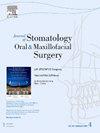前颌单体推进术中的牵引位置和牵引幅度:病例系列。
IF 1.8
3区 医学
Q2 DENTISTRY, ORAL SURGERY & MEDICINE
Journal of Stomatology Oral and Maxillofacial Surgery
Pub Date : 2024-10-01
DOI:10.1016/j.jormas.2024.101942
引用次数: 0
摘要
带内牵引的前额-面部整体推进术(FFMBA)是治疗面颅骨发育不良的核心手术。在内侧牵引技术中,一般会安置两套装置:双侧眶前牵引器和颞颧牵引器,采用颞舌沟截骨设计。一般认为,牵引器必须尽可能在水平面和矢状面上平行定位,以避免牵引过程中舌沟滑动骨片之间的机械冲突,从而优化推进幅度。因此,有人提出了几种方法来监测牵引器的位置,其中包括手术平面化和牵引器定位指南。为了探究牵引器定位是否需要手术规划,我们对 19 例 FFMBA 手术中 4 个牵引器位置的平行度进行了评估,并将一组 10 个牵引器角度与推进程度进行了关联。我们发现,在前牙整体推进术中,舌侧和龈沟的水平切迹可以作为颞颧下牵引器定位的标志。在其他条件相同的情况下,其他参数(两个同侧和两个对侧分心器的相对位置以及舌和舌沟垂直和水平切迹的方向)不会干扰分心。我们的研究结果表明,如果根据视觉监测将装置尽可能平行地定位,分心器的方向并不是前牙单颌前突的关键问题。本文章由计算机程序翻译,如有差异,请以英文原文为准。
Distractor position and distraction amplitude in fronto-facial monobloc advancement : A case series
Fronto-facial monobloc advancement with internal distraction (FFMBA) is a central procedure in the management of faciocraniosynostoses. In techniques with internal distraction, two sets of devices are generally positioned: bilateral fronto-orbital and temporo-zygomatic distractors, using a temporal tongue and groove osteotomy design. It is believed that distractors must be positioned as parallel as possible in the horizontal and sagittal planes to avoid mechanical conflicts between the sliding bone fragments of the tongue and groove during distraction, and thus optimize the advancement amplitude. Several approaches involving surgical planification and guides for distractor positioning have thus been proposed to monitor distractor placement.
To explore the need for surgical planification in distractor placement, the parallelism of the position of the 4 distractors was assessed in 19 FFMBA procedures and we correlated a set of 10 distractor angles with the degree of advancement.
We report that the horizontal cut of the tongue and groove can be used as a landmark for the positioning of the lower, temporo-zygomatic, distractor in fronto-facial monobloc advancement. Other parameters (relative position of the two homolateral and the two contralateral distractors and the orientations of the vertical and horizontal cuts of the tongue and groove) do not interfere with distraction, other things being equal.
Our results indicate that distractor orientation is not a critical issue in fronto-facial monobloc advancement when devices are positioned as parallel as possible based on visual monitoring.
求助全文
通过发布文献求助,成功后即可免费获取论文全文。
去求助
来源期刊

Journal of Stomatology Oral and Maxillofacial Surgery
Surgery, Dentistry, Oral Surgery and Medicine, Otorhinolaryngology and Facial Plastic Surgery
CiteScore
2.30
自引率
9.10%
发文量
0
审稿时长
23 days
 求助内容:
求助内容: 应助结果提醒方式:
应助结果提醒方式:


